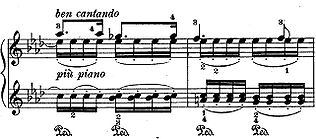Piano Sonata No. 3 (Brahms)
Johannes Brahms composed most of his Piano Sonata No. 3 in F minor opus 5 in October 1853. The second and fourth movements were composed before the rest of the sonata. The second and third movements were premiered on October 23, 1854 by Clara Schumann in Leipzig, the first performance of the entire sonata took place six weeks later by the pianist Hermann Richter in Magdeburg.
Sentence names
The five sentence names are
- Allegro maestoso
- Andante espressivo
- Scherzo : Allegro energico
- Intermezzo : Andante molto
- Finale: Allegro moderato ma rubato
music
Allegro maestoso
A dotted four-tone group becomes the central motif of the movement. The expressive secondary theme of the 70 bar long exposition penetrates into distant keys in a modulating manner and enlarges its sound range on both sides. A Liedkantilene in the tenor derived from fragments of the main theme, creates in the implementation contrast with the hard accents of the start; the recapitulation initially takes up the musical material from the beginning, but it soon leads from F minor to F major, the key in which the sonata finally ends.
Andante
Brahms prefixes the Andante with three lines of verse by CO Sternau :
The evening is dawning, the moonlight is shining
there are two hearts united in love
and blissfully embraced
In terms of form, it is a song form A - B - A with a coda at the end, whereby each of the parts is divided into itself. It is actually a form A1 - A2 - A1 - B1 - B2 - B1 - B2 - B1 - A1 - A2 - A1 - Coda. The coda takes up motifs from the earlier parts and leads on to the third movement.
At the end of October 1854, Brahms wrote the following letter to Clara Schumann from Hamburg :
- "... Couldn't you have a" good morning "telegraphed every day? I would be electrified, would be funny all day and how could I play. I can never take it long without you, why didn't you suffer that I learned to play the flute and traveled with you. Do you think I would have arranged the Andante from the F minor sonata for flute, guitar and timpani and serenaded you with Miss Schönerstedt and Pfundt. ... "
scherzo
The third movement takes up the mood of the first movement. The music is dominated by dance rhythms. The head motif goes back to the original cell of the first movement. The two parts gradually approach each other, the left hand steadily rises upwards, while the right hand moves downwards in arching movements. The calm radiating trio is typical of the density and weight present in Brahms even in lyrical passages and also has canonical approaches.
intermezzo
The inserted between Scherzo and Finale 4th movement, which extends the four movements of five sets is a funeral march , in contrast to the funeral marches from the second Sonata of Chopin or the 12th Sonata of Beethoven , the impression of the funeral march not by a continuous rhythm is created, but rather by sixteenth note triplets, which conjure up a kind of drum roll effect.
final
In the fifth and last movement of the sonata, the equestrian rhythm dominates, i.e. in eighth notes on beats 1, 3, 4 and 6 in a 6/8 time, a rhythm that is tonally similar to the horse's gallop. In terms of shape, this set is a free rondo shape. In addition to the rider's rhythm, the question-answer motivic system catches the eye. With the coda there is an apotheosis in F major, here too one encounters the equestrian motif.
Parallels to Schumann
The composer played Robert Schumann all of his early works, including this piano sonata. In his article Neue Bahnen, Schumann praised Brahms as the one called, as a kind of messiah of music. The fact that many of the motifs in this sonata are based on Schumann's music should therefore be seen as a kind of show of respect for the older composer and patron.
Recordings
A complete recording of Brahms' piano works by Julius Katchen , published by Decca Records, is known. Further recordings exist by the Russian pianist Anatol Ugorski , published by Deutsche Grammophon, Grigori Sokolow , published by opus 111 and by Artur Rubinstein , published by RCA. There are also recordings with Hélène Grimaud at Denon, with Solomon at Sbt, with Claudio Arrau at Philips, with Lars Vogt at EMI, with Daniel Barenboim at Teldec, with Antti Siirala at Ondine, with Andreas Boyde at Oehms Classics, with Francois Kerdoncuff at Tim and with Hardy Rittner at MDG , with Burkard Schliessmann at Antes Edition Classics and Bayer and with Igor Shukow at telos music records. Even Wilhelm Kempff played the Sonata for German Grammophon one, and Edwin Fischer for Electrola .
